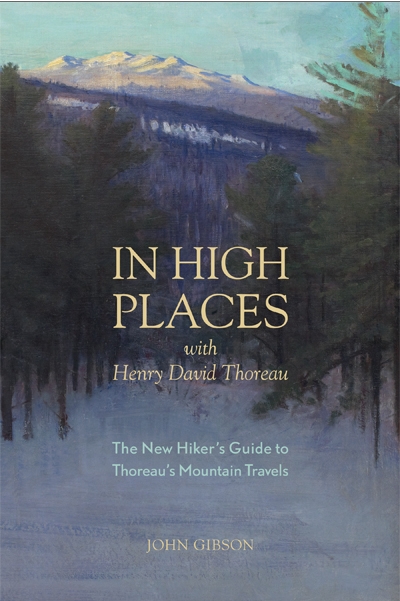Henry David Thoreau continues to be sliced and diced, every facet of his contradictory character polished to yield up its hidden wisdom.
The author of “In High Places with Henry David Thoreau: The New Hiker’s Guide to Thoreau’s Mountain Travels” lists Thoreau on land, Thoreau on science, Thoreau on walking, Thoreau on the seasons among the titles readers of his book might go on to for more information.
Such specializing is both an advantage and a disadvantage when coming to terms with the notoriously conflicting musings of the sage of Walden.
It’s a disadvantage because one is only getting a glimpse of a piece of the man; an advantage because one has to worry less about consistency, although not completely.
Above his introduction, John Gibson uses a quote from Thoreau that begins, “It is only when we forget all our learning that we begin to know.”
And yet as Thoreau described, for example, “scrambling on all fours over the tops of ancient black spruce trees,” he was careful to add their scientific name, Albes nigra.
For the most part, “In High Places” celebrates Thoreau, the unaffected naturalist who thrilled to the song of a rose-breasted grosbeak, not the pontificator about a lake being Earth’s eye in which to measure the depths of one’s nature. What does it mean?, as an English teacher used to scribble in the margins of my teenage creative excesses.
Not that Gibson shies away from Thoreau’s own musings. They are liberally highlighted throughout, first at the head of each chapter, then as pull-outs on the pages that follow.
As its full title indicates, the object of his book is to have Thoreau as a hiking companion, or rather for the latter-day hiker to accompany Henry David himself on his mountain rambles.
That the author wishes to keep the latter perspective front and foremost is made clear by the way he has organized “In High Places.”
Each of its 12 chapters corresponds to an expedition up a particular peak, but they are presented in the order that Thoreau climbed them, not according to geographical proximity.
One is implicitly invited to follow Thoreau’s footsteps rather than enjoy his insights while making one’s own explorations.
Topographical clarity is thus sacrificed for historical continuity.
Gibson introduces each chapter (after quoting a relevant passage from the sage’s journals) with an account of Thoreau’s own ascent.
He has a splendid knack for finding good quotes to embellish the narrative.
Of Katahdin, Thoreau wrote that it “had a singularly flat table-land appearance, like a short highway where a demi-god might be let down to take a turn or two in an afternoon to settle his dinner.”
Thoreau was an intrepid walker for whom 10 to 15 miles a day (generally fueled by blueberries) just to reach the mountain was standard. Most readers of “In High Places” will be content to start at its foot.
Gibson follows each historical tale with detailed directions for a hike today that as much as possible proceeds as Thoreau did.
Thoreau, who boasted of traveling light and made a point of bushwhacking directly for a peak rather than following someone else’s path, might have smiled at Gibson’s repeated attention to the need for proper equipment and staying on the trail.
For all the use of a new sans serif typeface to differentiate today’s route descriptions from Thoreau’s own experiences, there is a good deal of overlap in each chapter, which seems to get more marked as the book goes on.
Gibson is the author of a number of walking guides, including “Weekend Walks along the New England Coast” and “50 Hikes in Coastal and Southern Maine.”
He has a felicitous style that softens hard facts with compelling images: “A bold fissure created by moving water, weathering, synclinal pressure, and ice, the Flume exposes the rocky innards of these hills.”
Occasionally, though, a piece of self-evident waffle slips in: “The effects of this glaciation were evident in Thoreau’s time and are still visible today.”
There are excellent maps for each hike, but the illustrations are gray rather than black and white, and add little.
What stayed with me as I closed “In High Places” was Thoreau’s unalloyed thrill at the beauty of mountains.
He never put it better or more simply than when, after watching evening descend on Mount Lafayette, he wrote in his journal, “It was the grandest mountain view I ever got.”
Thomas Urquhart is a former director of Maine Audubon and author of “For the Beauty of the Earth.”
Copy the Story Link
Send questions/comments to the editors.



Success. Please wait for the page to reload. If the page does not reload within 5 seconds, please refresh the page.
Enter your email and password to access comments.
Hi, to comment on stories you must . This profile is in addition to your subscription and website login.
Already have a commenting profile? .
Invalid username/password.
Please check your email to confirm and complete your registration.
Only subscribers are eligible to post comments. Please subscribe or login first for digital access. Here’s why.
Use the form below to reset your password. When you've submitted your account email, we will send an email with a reset code.